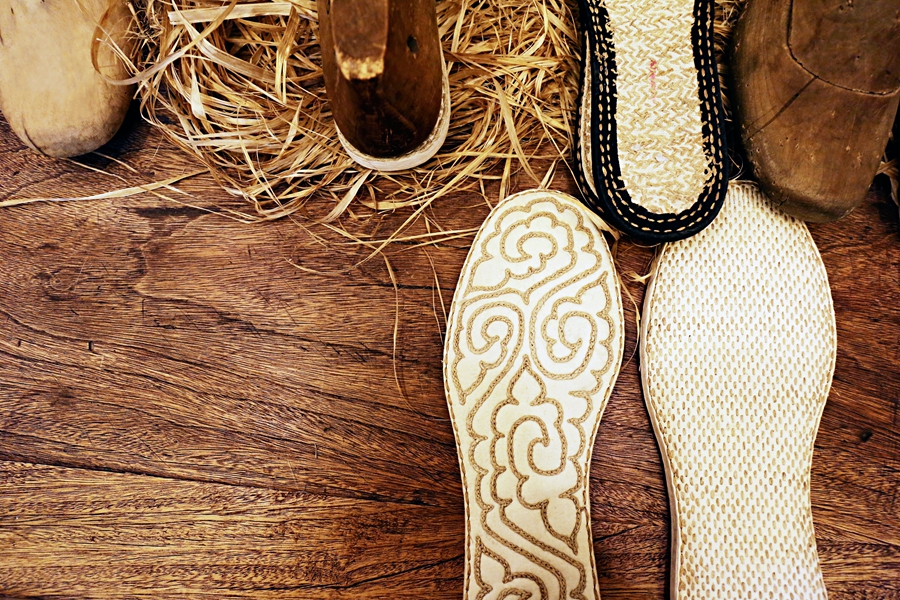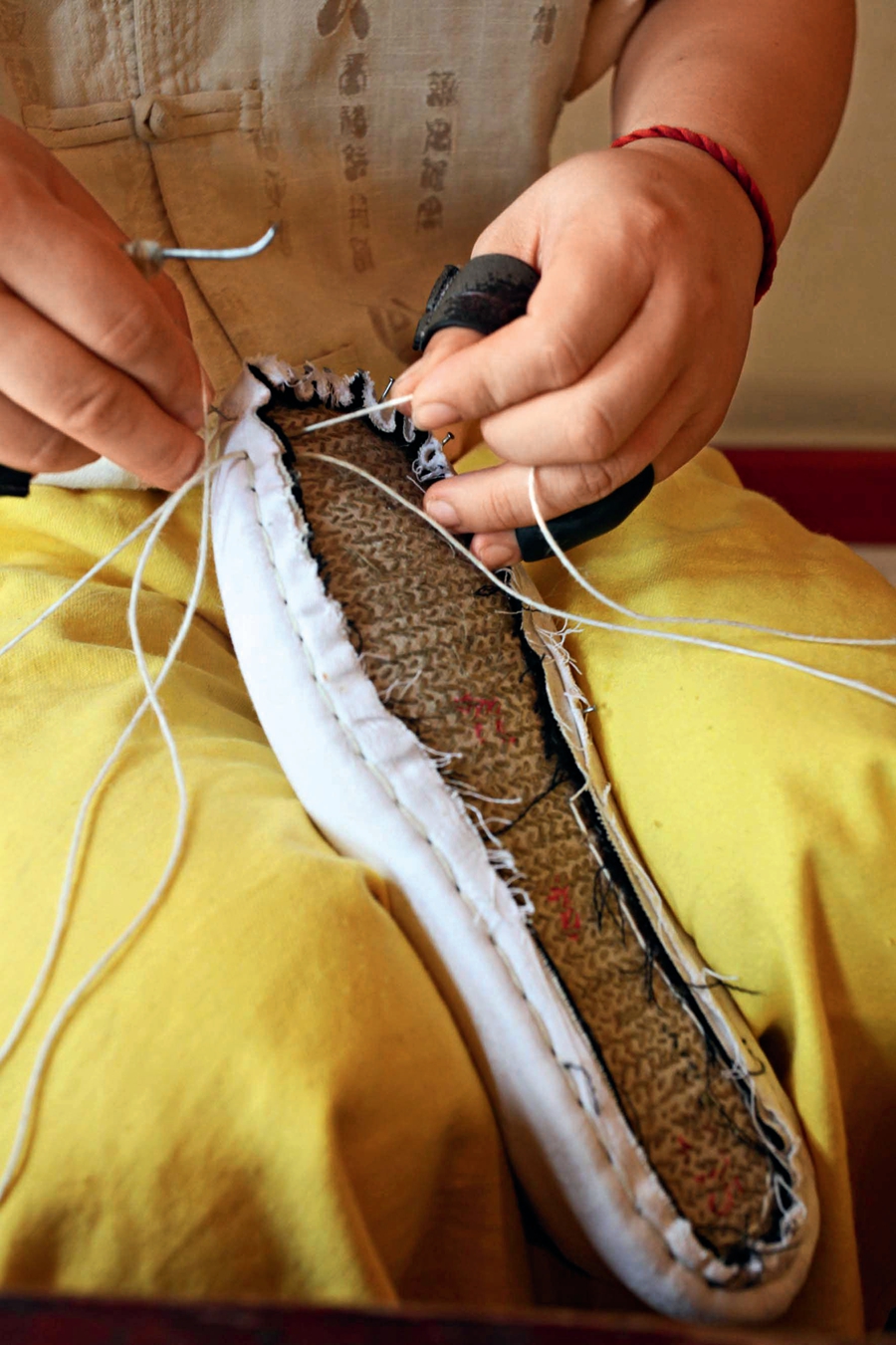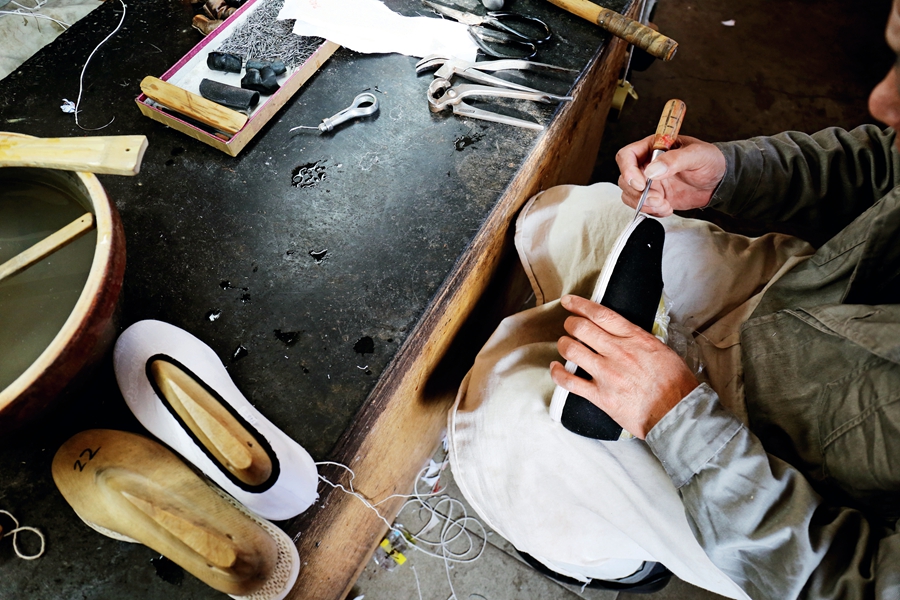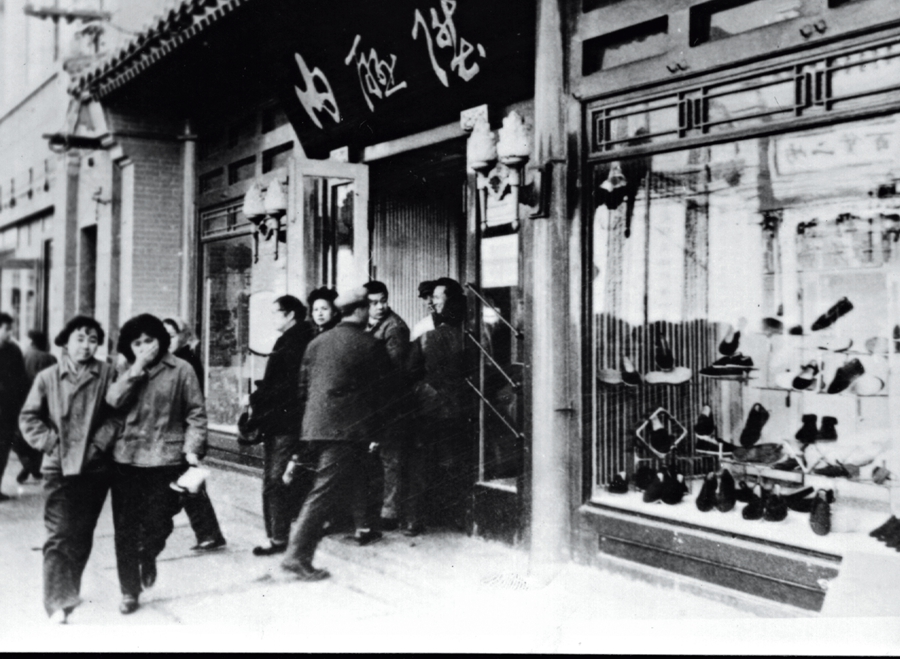By staff reporter JIAO FENG
WITH a history of more than 3,000 years, cloth shoes had been the major footwear in China till the mid-20th century. In the past, cloth shoes were mostly hand-made. Their comfortability and durability mainly hinged on a good shoe sole, which should not hurt your feet and also be able to endure abrasion. Therefore, the multi-layered sole, sewn from pieces of cloth, constituted the most important part of the hand-made cloth shoe. Owing to its multiple layers, the sole acquired its name qiancengdi (literally meaning thousand-layered sole). Therefore, hand-made cloth shoes are also called qiancengdi cloth shoes.
Hand-made Shoes with Love
In older times, when the commodity economy was far less developed, people relied on their dexterous hands to make their garments. Now in China, most elderly people still remember that in their childhood, whenever the Chinese New Year was coming, their mothers would take out all used clothes and odd bits of cloth they had gathered for a whole year. By cutting and splicing, their mothers made new shoes for every family member with bits and pieces of cloth. Under the dim light of the old-type lamp, the silhouettes of their hardworking mothers became the warmest and most nostalgic memory for many senior Chinese.
A pair of well-made qiancengdi soles features tight and evenly distributed stitches. A pair of ordinary soles requires at least 2,100 stitches.
In rural China, being able to make a pair of presentable and comfortable cloth shoes was regarded as an essential aptitude for a girl, a yardstick for her dexterity. Unmarried girls should not make shoes for men other than their father and brothers. If she did, then it indicated she was interested in another man. Sending a man a pair of personally hand-made cloth shoes is a bold profession of love. When young people fell in love, the girl often secretly bought a piece of cloth, sewed a pair of cloth shoes, and sent them to her lover as a token of her affection.
A craftsman of the time-honored shoe store Nei-liansheng demonstrates the process of making qiancengdi cloth shoes.
After tracing the shoe pattern onto a piece of fabric and then cutting it out, the only strenuous work left is sewing the shoe soles using dense stitches.
Sewing shoe soles is different from ordinary sewing work. After each stitch, you have to tighten the thread, and stitches should be dense.
Despite the name qiancengdi, the cloth shoe soles don’t have to have 1,000 layers. People use the term to stress the thickness and solidity of the hand-made sole. It’s important to brush two or three layers of cloth with flour-made paste and stick them together, and allow them to dry in the air. Cut out the sole patterns from it and edge the soles. Then stack them up tidily, sew them together along the contour of these layers, and start sewing in thousands of stitches. A one-cm-thick sole will then begin to take shape. Its side view makes its edged layers clearly visible.
Qiancengdi cloth shoes are light, soft, comfortable, and breathable, and also help you avoid foot odor. Therefore, they are particularly suitable for children and elderly people. In addition, as Chinese elements become more valued nowadays in fashion designs, these comfortable and typically traditional Chinese-style qiancengdi cloth shoes are becoming the favorite of more and more young Chinese people.
A Time-honored Brand
In the late 19th century, four items were regarded as the necessary accompaniments of a successful man in Beijing, as the saying goes “A Majuyuan hat on the head, a pair of Neiliansheng shoes on the feet, dressed in clothes made from silks and satins from Beijing’s eight renowned fabric shops, and with banknotes issued from Beijing’s four major private banks in the pocket.”
Well-made qiancengdi cloth shoes should be in a good shape. Therefore, a set of strict making steps is required. Moreover, the final trimming and shaping procedure is very important with special tools used to achieve a high quality finished product.
Neiliansheng was founded in 1853. Its founder Zhao Ting first worked as an apprentice in a Beijing shoemaking workshop. His smartness and exceptional perception of the profession made him quickly become a master craftsman. After accumulating abundant client resources and managerial experience, Zhao decided to start his own business. Zhao made an insightful analysis of Beijing’s shoemaking industry, and thought what Beijing lacked was a shop making official boots for the imperial court members. So, Zhao opened a shop for royal members and feudal officials.
The shoe shop’s name Neiliansheng has auspicious implications: nei referred to the royal court, liansheng indicates people wearing the boots made by the shop would have a successful official career. Neiliansheng selected high-grade lustrous black satin to make boots, easy to clean and wear resistant. Owing to its excellent workmanship, Neiliansheng-made boots were comfortable and light despite their 32-layered soles. The boots also make no sound when walking across the ground. All these merits made the boots both dignified and stylish. On top of that, to ensure the fit, each pair of boots produced by Neiliansheng was custom-made based on a specific client’s size.
Neiliansheng soon won the favor of royal family members who then became their regular customers, and thus secured the brand’s dominant position in Beijing’s footwear industry. Even Qing Emperor Xuantong’s dragon boots, which the emperor wore at his crowning coronation ceremony, were made by Neiliansheng.
Apart from its top-grade products, another secret of Neiliansheng’s successful business was its client-centered concept. Its founder, Zhao Ting paid utmost attention to the needs of his clients. Whenever a new client patronized his store, Zhao would record their boots sizes and styles, and their specific feet shapes and sizes. Then a journal called Lüzhong Beizai (detailed information about boot wearers) recording client’s detailed information came into being. The brochure was only kept inside the store. When the documented client wanted to buy a pair of new boots, he only needed to send people to tell the store. Then Neiliansheng would make the boots based on the recorded information.
The storefront of Neiliansheng in 1978.
After the Qing Dynasty perished, court boots soon receded from people’s life. Neiliansheng confronted its historical transition. Hand-made cloth shoes thus became its major products. Influenced by its former court boot making tradition, Neiliansheng still only targeted male customers. Only after the founding of the People’s Republic of China did the shoe brand begin to introduce female and children’s footwear.
As the society continued to advance, leather shoes and sneakers became the dominant footwear, and people’s demands for cloth shoes dropped. However, the shrinking market has not lowered Neiliansheng’s high standard for quality; being hand-made is still its hallmark. After unremitting exploration and with inheritance of several generations, Neiliansheng has formed its unique hand-made cloth shoes making craftsmanship. It has not only retained all making procedures of traditional hand-made cloth shoes, but also formulated technological standards for each procedure and relevant environmental protection standards. In 2008, Neiliansheng’s qiancengdi cloth shoes making craftsmanship was put on the national intangible cultural heritage list.
Inheritance-based Further Development
The seemingly simple cloth shoes demand a very complicated process with many time-consuming and laborious procedures and a high requirement for excellent craftsmanship. To make a pair of qiancengdi cloth shoes, Neiliansheng uses 90 procedures. If all the work is done by one person, it takes him or her around a week to finish making a pair of shoes.
To make cloth shoes, making the soles comes first. Layers of cotton cloth are pasted together with starch. When the stack of pasted cotton cloth layers reaches 1.5 mm, it is left to dry. Ordinary people usually use wore clothes or odd bits of cloth as material for the sole. However, Neiliansheng uses brand new cotton cloth and their paste is also made from high gluten flour for its good stickiness. After the cloth is hardened, cut sole patterns out of them. Edge each sole pattern with white cloth, and stack up the edged sole patterns. Fasten eight or nine edged sole patterns by sewing them together with hemp cord along their edges. Then start sewing the sole.
Usually a kind of custom-made hemp cord is required in this process. The needle should be thin, but the hemp cord should be comparatively thick. After each stitch, the sewer has to tighten the cord. It’s said that only in this way can the hand-made sole be solid and durable. Neiliansheng-produced soles feature tidily arrayed stitches; a length of one cun (about 3.3 cm) covers nine stitches. Calculating this way, an ordinary pair of soles requires at least 2,100 line-shaped stitches, or 4,200 cross-shaped or herring-bone-shaped stitches. After sewing, the sole still needs to be soaked in hot water and put under high temperatures. Then, hammer it for shaping. After that, the qiancengdi finally takes shape.
Sole sewing can only be made by hand. The main reason is that machine stitches will come loose if one stitch breaks. The hand-stitched sole, owing to the thin needle, thick hemp cord and tight sewing, would see no harm even if one stitch is frayed because after the soaking procedure, the hemp cord jam-packs all the needle holes.
After the qiancengdi is ready, it’s time to make the upper part of the shoe. Neiliansheng’s traditional choice for this part is cotton or wool fabric. Today, to attract more young clients, it also uses canvas and silk. The color also changed from just black to more colors, with some involving colored drawings and fancy embroidery. It has cooperated with several popular footwear brands to add more fashion elements to its products.
Lastly, bind the upper part and sole together. To match them well, the sewing stitches should be small and arranged in an orderly fashion, and the left and right sides of the upper should be balanced and not go beyond the shoe edge. The final step is to shape the shoe with a shoetree to make it fit better.
Each step of the process is important and related to the quality of the final product, in particular the comfortableness. The skills needed usually take a person several years to master, and can’t be improvised.
Neiliansheng’s fourth successor He Kaiying believes in hands-on teaching. He is intent on passing on the qiancengdi cloth shoe making artistry to the younger generation. As for the time-honored shoe brand’s development concept, its president Cheng Laixiang summarized, “Our goal is not about the size of the business. What we are pursuing is passing on our traditional craftsmanship.”
(Compiled by China Today)



